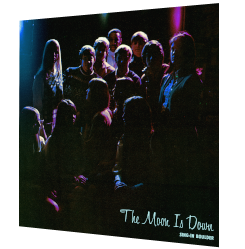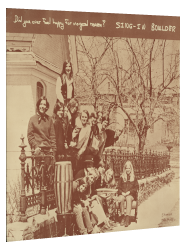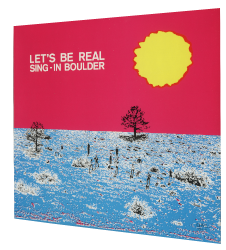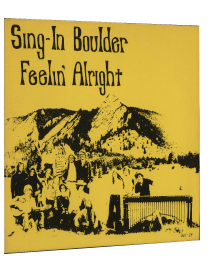
The Music. The Magic.
From the back cover of The Moon Is Down CD:
"One magical night in January, 1969, sixteen people hovered behind the
curtain as the Boulder High School auditorium filled: tuning, whispering,
and exchanging glances. As stagehands dimmed the houselights, the crew
assembled on stage, not talking for a change. Something hung in the air,
heavy enough to cut with a knife, a feeling of stifled frenzy. Then the
curtains parted to the sounds of and the intensity reached into the packed house. The show was carried
by its own momentum; and when the company finished with
a standing ovation left the
performers limp."
Help Us Help Others!
You can help send a kid to nature camp at the Thorne Nature Experience, founded by the original producer of the Sing-In Boulder LP albums, Dr. Oakleigh Thorne II, who has generously endorsed this re-release.
 We sat cross-legged on the floor, listening to a record player (not a stereo
system), watching the 45 RPM single Yesterday spin, playing it over
and over. We passed guitars around, singing the songs mentioned above and
strumming the four chords of If I Had a Hammer, singing Peter, Paul
& Mary's A' Soalin', and inevitably imitating Eric Burdon and The
Animal's The House of The Rising Sun, a revived, traditional
folk song first published in 1925.
The civil rights movement was still going strong, and central to the
revival of the traditional gospel song. Although most remember We
Shall Overcome, a descendent of a gospel song written in 1900,
written in the 1920's,
was also considered an anthem of the movement.
( is recorded
on the Sing-In The Moon Is Down album).
The turbulent times of the still-threatening Cold War, the emerging Vietnam
War and the escalated draft fueled the sentiments of our new, idealistic
generation that had never endured the hardship of the depression or world-wide
conflict.
The opening verse of Peter Yarrow's also on Sing-In's The Moon Is Down, captures the essence of the generation
gap:
We sat cross-legged on the floor, listening to a record player (not a stereo
system), watching the 45 RPM single Yesterday spin, playing it over
and over. We passed guitars around, singing the songs mentioned above and
strumming the four chords of If I Had a Hammer, singing Peter, Paul
& Mary's A' Soalin', and inevitably imitating Eric Burdon and The
Animal's The House of The Rising Sun, a revived, traditional
folk song first published in 1925.
The civil rights movement was still going strong, and central to the
revival of the traditional gospel song. Although most remember We
Shall Overcome, a descendent of a gospel song written in 1900,
written in the 1920's,
was also considered an anthem of the movement.
( is recorded
on the Sing-In The Moon Is Down album).
The turbulent times of the still-threatening Cold War, the emerging Vietnam
War and the escalated draft fueled the sentiments of our new, idealistic
generation that had never endured the hardship of the depression or world-wide
conflict.
The opening verse of Peter Yarrow's also on Sing-In's The Moon Is Down, captures the essence of the generation
gap:
So I told him that he'd better shut his mouth And do his job like a man. And he answered "Listen, Father, I will never kill another." He thinks he's better Than his brother who died. What the hell does he think he's doing To his father who brought him up right?
 Simon and Garfunkle burst onto the scene with The Sound of Silence,
bolstering the popularity of the smooth, harmonic and thoughtful male duet
style we hear in the Sing-In original songs and and in Paul Simon's
on The Moon Is Down
album. Paul Simon's is on the
Feelin' Alright album.
Musicians who frequented or lived in or near Boulder, like Stephen Stills
and
and Neil Young
and
also added their influence. Many of
us skipped class and attended Stephen Stills' and Neil Young's impromptu, free
concert in the City Park band shell (just down the street from Boulder High),
highlighted by Still's Buffalo Springfield classic, For What It's Worth
(Stop, Hey What's That Sound). Frequent Colorado visitor Michael Martin
Murphey co-authored and Judy Collins' powerful
performances of and
inspired their Sing-In
counterparts.
Simon and Garfunkle burst onto the scene with The Sound of Silence,
bolstering the popularity of the smooth, harmonic and thoughtful male duet
style we hear in the Sing-In original songs and and in Paul Simon's
on The Moon Is Down
album. Paul Simon's is on the
Feelin' Alright album.
Musicians who frequented or lived in or near Boulder, like Stephen Stills
and
and Neil Young
and
also added their influence. Many of
us skipped class and attended Stephen Stills' and Neil Young's impromptu, free
concert in the City Park band shell (just down the street from Boulder High),
highlighted by Still's Buffalo Springfield classic, For What It's Worth
(Stop, Hey What's That Sound). Frequent Colorado visitor Michael Martin
Murphey co-authored and Judy Collins' powerful
performances of and
inspired their Sing-In
counterparts.
 Woodstock had happened, and we were able to get Joan Baez to appear at
an assembly at Boulder High where she did sing for us briefly.
Among The Beatles Peter Paul & Mary and
Simon and Garfunkle Cosby, Stills, Nash & Young
(Stephen Stills' and
and Neil Young's and
The Bee Gees and
Joni Mitchell and
their musicians account for songwriter credits on seventeen of the
songs on the four Sing-In albums. Other noted contributing songwriters
include
Donovan Leitch Buffy Sainte-Marie James Taylor John Denver and
Cat Stevens
The students themselves contributed ten original songs,
(listed under an alias, but also sampling Arlo Guthrie's Alice's
Restaurant),
and
The word "genre" had not yet come into the vocabulary, but folk rock
had come into our lives.
Woodstock had happened, and we were able to get Joan Baez to appear at
an assembly at Boulder High where she did sing for us briefly.
Among The Beatles Peter Paul & Mary and
Simon and Garfunkle Cosby, Stills, Nash & Young
(Stephen Stills' and
and Neil Young's and
The Bee Gees and
Joni Mitchell and
their musicians account for songwriter credits on seventeen of the
songs on the four Sing-In albums. Other noted contributing songwriters
include
Donovan Leitch Buffy Sainte-Marie James Taylor John Denver and
Cat Stevens
The students themselves contributed ten original songs,
(listed under an alias, but also sampling Arlo Guthrie's Alice's
Restaurant),
and
The word "genre" had not yet come into the vocabulary, but folk rock
had come into our lives.
